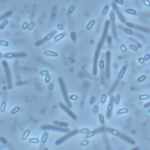Lien vers Pubmed [PMID] – 35202151
Lien DOI – 10.3390/toxins14020124
Toxins (Basel) 2022 Feb; 14(2):
Protein secretion is generally mediated by a series of distinct pathways in bacteria. Recently, evidence of a novel bacterial secretion pathway involving a bacteriophage-related protein has emerged. TcdE, a holin-like protein encoded by toxigenic isolates of Clostridioides difficile, mediates the release of the large clostridial glucosylating toxins (LCGTs), TcdA and TcdB, and TpeL from C. perfringens uses another holin-like protein, TpeE, for its secretion; however, it is not yet known if TcdE or TpeE secretion is specific to these proteins. It is also unknown if other members of the LCGT-producing clostridia, including Paeniclostridium sordellii (previously Clostridium sordellii), use a similar toxin-release mechanism. Here, we confirm that each of the LCGT-producing clostridia encode functional holin-like proteins in close proximity to the toxin genes. To characterise the respective roles of these holin-like proteins in the release of the LCGTs, P. sordellii and its lethal toxin, TcsL, were used as a model. Construction and analysis of mutants of the P. sordellii tcsE (holin-like) gene demonstrated that TcsE plays a significant role in TcsL release. Proteomic analysis of the secretome from the tcsE mutant confirmed that TcsE is required for efficient TcsL secretion. Unexpectedly, comparative sample analysis showed that TcsL was the only protein significantly altered in its release, suggesting that this holin-like protein has specifically evolved to function in the release of this important virulence factor. This specificity has, to our knowledge, not been previously shown and suggests that this protein may function as part of a specific mechanism for the release of all LCGTs.

